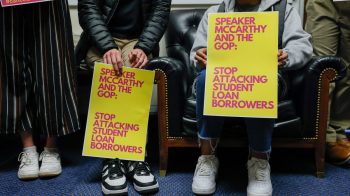President Obama’s aid to student borrowers is okay. It will allow graduates to consolidate and reduce the interest rates on their student loans. It should allow up to 5.8 million people with both direct government student loans and government-backed private loans to consolidate their debts and take advantage of today’s low interest rates.
The Administration is also moving up the timetable for improvement with the Income-Based Repayment (IBR) plan from 2014 to 2012. Net year borrowers will be able to pay 10% of income toward their loans, down from the current 15%. The debt will be forgiven in 20 years, down from 25 years. I’m a fan of the IBR program, especially with the terms that now kick in 2012.
The moves are welcome. But they’re really a band-aid. It’s time for Congress and the Administration to take a more fundamental look at how we pay for college and move away from a heavy reliance on borrowed money.
After all, the price tag for earning a college sheepskin keeps spiraling higher, with tuition and fees increasing at about two times the overall rate of consumer price inflation in recent decades.
For example, the average tuition and fees alone for attending an out-of-state public university for the 2011-12 school year are $20,770 and $28,500 for a private nonprofit college. The comparable price tag in 1995/96 was $4,020 and $17,460.
Meanwhile, wages of young college graduates have been stagnant to down over the past decade. Economist Michael Mandel calculates that the inflation-adjusted earnings of male college graduates fell by 9.7% decline in real pay from 2000-2010 (that’s bachelor’s only, 25 and older). The real earnings of their female peers were flat over the same time period. The pay numbers are even worse for young college grads.
Job offers have been scarce ever since the economy sank into the Great Recession toward the end of 2007. Students and their parents are borrowing more than ever.
Here’s the rub: The college financing system relies too much on loans to pay for education. For more than three decades, students and their parents have funded a college-tuition bubble with borrowed money. An ample supply of loans allowed colleges to raise the cost of attending their institutions at four times the rate of inflation over the past two decades. The credit-fueled spike in tuition costs has hit loan recipients hard.
I like the approach proposed by the late economist Milton Friedman, Nobel laureate at the University of Chicago.
In a 1955 article “The Role of Government In Education” Friedman noted that loans weren’t a good way to finance higher education and professional training. “Such an investment necessarily involves much risk,” he wrote in 1955. “The average expected return may be high, but there is wide variation about the average.”
Debt is too risky for a start-up business and a college graduates. he stock market points to a better way, said Friedman:
The device adopted to meet the corresponding problem for other risky investments is equity investment plus limited liability on the part of shareholders.The counterpart for education would be to ‘buy’ a share in an individual’s earning prospects: to advance him the funds needed to finance his training on condition that he agree to pay the lender a specified fraction of his future earnings. In this way, a lender would get back more than his initial investment from relatively successful individuals, which would compensate for the failure to recoup his original investment from the unsuccessful.>
Think of it as making a student’s four-year degree – and postgraduate pursuits — a kind of private equity deal with the government.
This approach would do away with the torturous process of figuring out expected family contributions. The baseline method for paying for college would come out of future earnings. The repayments would come through the progressive income tax system eliminating the need for much of the existing bureaucracy. Grants could be targeted at low income students.
A system like this would allow graduates greater freedom to explore the job market. They would have some financial protection against the luck of the draw, such as graduating during the Great Recession. They would no longer have to worry about paying back their student loans if they had an accident or lost their job. The proposal is far from radical: It buiolds on the current IBR program. More important, Australia already has a progressive tax based repayment system.
The lesson of history is that more education is better than less. The lesson of the Great Recession is that America took on way too much debt. Let’s turn away from borrowing and embrace equity financing in the nation’s best and brightest. The return on investment will more than pay for itself.
There’s a lot happening in the world. Through it all, Marketplace is here for you.
You rely on Marketplace to break down the world’s events and tell you how it affects you in a fact-based, approachable way. We rely on your financial support to keep making that possible.
Your donation today powers the independent journalism that you rely on. For just $5/month, you can help sustain Marketplace so we can keep reporting on the things that matter to you.


















